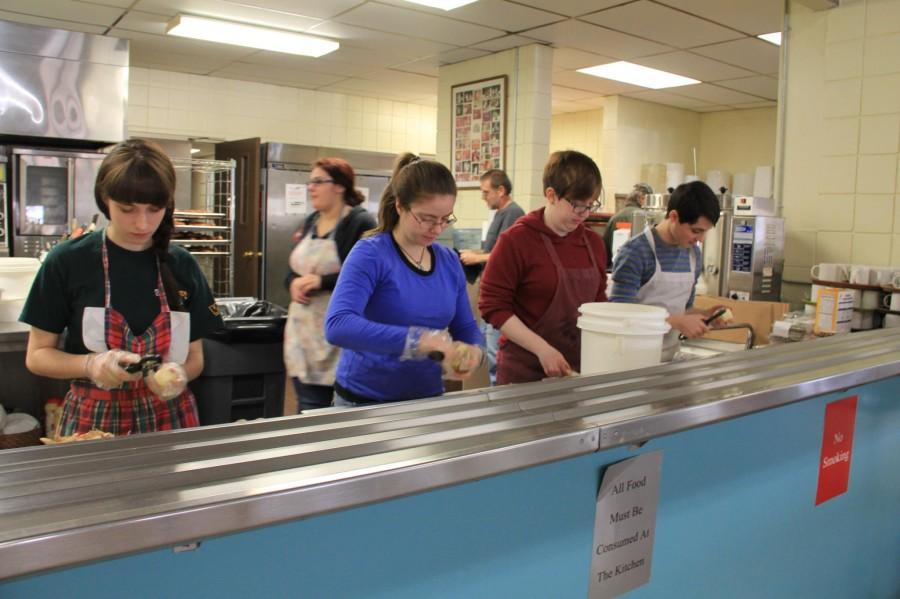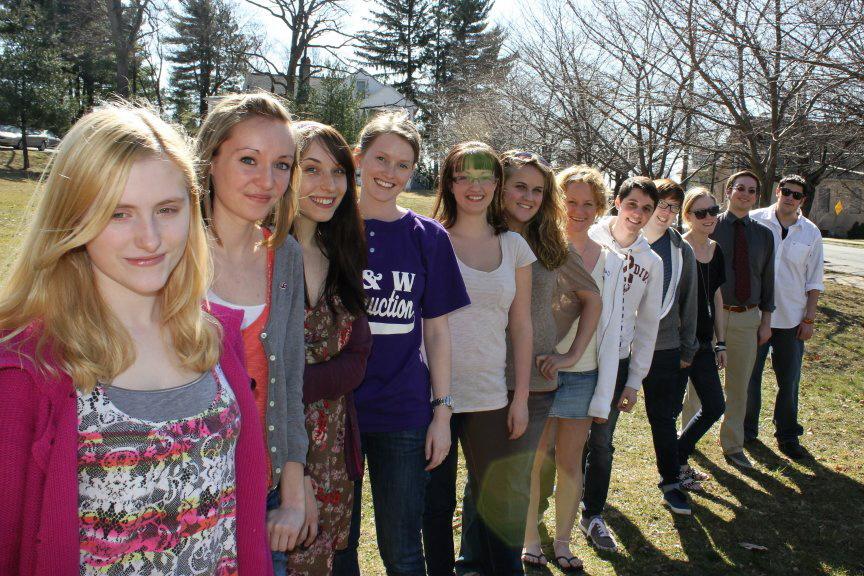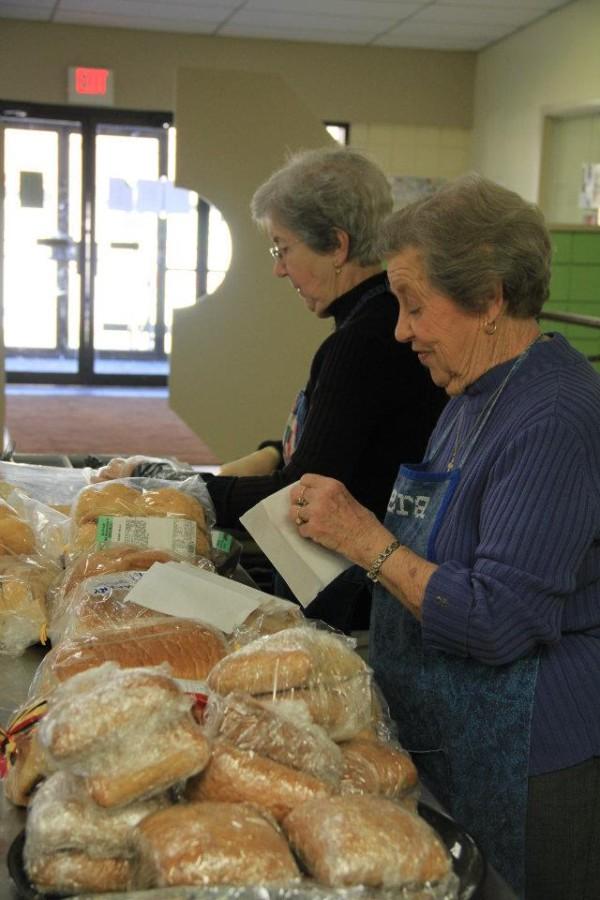A group begins to form outside of a small, discreet, partially brown brick building on Penn Avenue in Scranton. The doors won’t open until close to 11:00 a.m., but the clients gather early.
By 10:30 a.m., the line of patiently waiting individuals has substantially increased in number. At approximately 10:50 a.m., the glass double-doors open and the crowd gathered outside is allowed into the foyer. There is no rush or chaos, just a calm anticipation for what is to come.
Unlike what some may think, this is not a crowd awaiting the launch of the newest piece of technology at a big-box store. On the contrary, they are waiting for what might be their only meal for the day.
This is what a routine day looks like at St. Francis of Assisi Soup Kitchen in Scranton. Once clients enter, the meal opens with a prayer from Msgr. Joesph Kelly, executive director, or one of the many regular volunteers. Once the prayer is complete, a volunteer calls out, “five at a time,” and the lunch procession begins.
The kitchen offers a daily lunch from 11 a.m. to noon, when volunteers serve approximately 200 meals, according to Msgr. Kelly.
“We are very dependent upon donations,” says Msgr. Kelly. Everything from food to volunteer time is donated to the soup kitchen. St. Francis receives food from local grocery stores, restaurants and even businesses like Auntie Anne’s Pretzels.
In addition to lunch, St. Francis of Assisi Soup Kitchen offers a dinner service on Tuesday, Wednesday and Thursday evenings from 5 – 6 p.m.
A diverse clientele
Msgr. Kelly explained that the clients, or those who benefit from the services offered by the kitchen, could be divided into three categories. They are the homeless, the “second tier,” and the working poor.
The first category could be described as the “real” homeless, or those who live outside year-round. They do not seek out the help of local shelters. “They live down along the river, under the bridge or various unsoundly spots,” said Msgr. Kelly.
The second category, or those that Msgr. Kelly refers to as the “second tier,” are people in transition between living on the streets and finding a residence. Through the help of Catholic Social Services, those in the second tier can stay in a shelter for 30 days while they work to get on their feet. From there, clients are able to move into transitional housing.
Finally, the third category benefiting from the services St. Francis provides would be the working poor. The working poor can be classified as those who are working part-time or full-time, but barely getting by. They are able to utilize the soup kitchen and in turn, put money toward their bills instead of worrying about feeding themselves.
While there are categories in place to classify the clients, an outside observer would find it difficult to tell them apart by appearance alone.
“No money, no honey”
Miguel, a St. Francis client, now frequents the kitchen since becoming homeless a few years ago.
A short, stocky man, Miguel greeted friends and others with a broad smile. He wore a baseball cap over salt-and-pepper colored hair, a crew neck sweatshirt and a pair of jeans. At first glance, Miguel doesn’t outwardly show any sign of being homeless.
Miguel, born in Guatemala, came to the United States at 19 years-old to help support his family. According to Miguel, he worked odd jobs throughout the country until finally settling in the Scranton/Wilkes-Barre area.
“I’m not here because I went to jail or fell into drugs. I’m here because of sad circumstances.” A former janitor, Miguel lost his job and ended up on the streets. The soup kitchen has been a great source to him over the past couple of years.
To add insult to injury, Miguel lost his wife after becoming jobless. “If you have no money, you have no honey,” said Miguel. This was a major contributing factor to Miguel’s homelessness.
Eligible for welfare, Miguel refuses to collect the benefits. “I want to work for myself,” said Miguel. However, because he does not have a permanent residence, Miguel is having a hard time finding a job. Until then, he said he will continue to utilize the kitchen.
According to feedingamerica.org, Pennsylvania’s food insecurity rate is 13.5%. Sadly, Miguel is one of the statistics.
Out of sight, out of mind
While the kitchen benefits greatly from the generosity of the public, it does face opposition from time to time. The St. Vincent de Paul Soup Kitchen in Wilkes-Barre deals with objection from the public due to its location near King’s College.
“There are certainly people in the community that would be happy if we got out of there,” Msgr. Kelly said.
Unlike in Wilkes-Barre, the kitchen in Scranton does not face any problems. The kitchen’s location on 500 Penn Avenue,situated across from a rundown warehouse, allows for an out of sight, out of mind mentality for the public, according to Msgr. Kelly.
People are willing to help the hungry explained Msgr. Kelly, but he explained that helping the hungry is about more than hunger.
“[The problem] isn’t just hunger, it’s poverty,” said Kelly. The public has a hard time supporting something they do not understand, he said. The image of poverty that the public has is sometimes less than favorable explained Kelly. “When guys are coming down the street and they stop behind a bush in your yard to relieve themselves, that is not as socially acceptable as hunger,” said Kelly, in regard to the public perception of food insecure vs. poverty.
With the state’s population closing in on 13 million that means nearly 1.7 million are facing food insecurity in this state alone. However, places like St. Francis of Assisi Soup Kitchen are helping to combat this problem in Scranton, Pennsylvania. According to the U.S. Census Bureau, at least 12.4% of Pennsylvanians were below the poverty line between 2006 and 2010.






